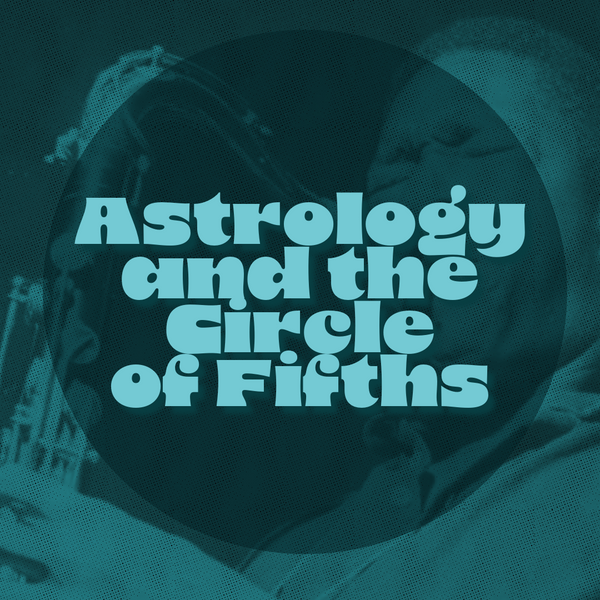This blog series draws from the work and calculations discovered and laid out by Hans Cousto in his seminal 1978 tome "The Cosmic Octave." If you find the info below to be resonant with you, we highly encourage you to purchase his book wherever you can find it...
Here's a fast link if you can't wait: The Cosmic Octave by Hans Cousto

Merci beaucoup, Hans Cousto!
In our first post in this blog series, I introduced the concept of the Cosmic Octave. I talked a little about the Law of the Octaves, exploring harmonics and other musical relationships.
In the second post in the series, I explored the idea of information and energy as both a physical and spiritual concepts and I looked at how we can connect quantitative information (hard numbers) with qualitative information (subjective, feeling).
In this entry, we're going to look at the actual planetary frequencies and try to figure out how Hans Cousto got us from planetary orbits to audible tones.
In music, the Octave is a unit of measurement between tones, where the higher tone has 2x the frequency of the lower tone. For example, C in the 3rd octave is 130.81 Hz, C in the 4th octave is 261.63 Hz. There is one full octave between them.
With the Cosmic Octave, we're applying the same principle to planetary orbits, calculating the upper octaves of each planetary orbit or period, within the audible range of frequencies.
The astronomical calculations Cousto used to determine the scaled, audible frequency for each planet were very precise. A difference or deviation of a few minutes when looking at a planetary cycle can have major implications once all of the octave doubling is done. To get the maximum amount of precision, Cousto used astronomical data down to fractions of a second when doing his original calculations.
As an example of his Cosmic Octave concept, Cousto asks us to look at one day. He takes a 45-minute period of the day and determines that 45 minutes is 1/32 of the full 24-hour period. 32 is the 5th power of 2 (2, 4, 8, 16, 32) so a 45-minute period is the 5th upper octave of one day. That's like a meeting at work. I can hear it now.
If you strike the lowest G on a piano, you'll get about 24 hz. If you go up 5 octaves–32x the frequency of the lowest G–and strike both G's at the same time, you'll be able to experience the time and frequency relationship between a 45 minute period and a full day. It sure sounds a lot nicer than a work meeting (not including Gongs Unlimited meetings which are fun and include shaved ice). You're hearing a relationship between one part of a thing and the whole of the thing.
We can calculate other relationships this same way, like determining which colors correspond to which planets for example. But today we're going to stay focused on the sound of the planets themselves.
As a more specific example, let's look at one full (solar, not sidereal) Earth Day. We know from existing astronomical calculations that one full solar 24-hour day is 86,400 seconds. We need to figure out what the Hz of a single day is.
We know that Hz is shorthand for "cycles per 1 second," and we also know that there's 1 cycle per 86,400 seconds in a full 24 hour day on Earth. Here, "cycle" is referring to one full rotation of the Earth around its axis, or, a single 24-hour day. With other planets, "cycle" may refer to a single revolution around the Sun. With the Moon, we can measure the cycle of the Moon against the Sun (synodic), or against the stars (sidereal).
So, digging into the recesses of our middle school mathematical minds, the algebraic equation we're find ourselves looking at is 1 cycle / 86,400 seconds = x cycles / 1 second, and we need to solve for the variable, x. Great. Algebra. It's only been 2 decades. How hard can it be, right?
1/86400 = x/1
I'm remembering now, I can hear my teacher, Mr. Cockerill, calling out to me in in the back row of my mind–"To find x, we use the "reciprocal value" button on a calculator (1/x) and that's how you do it!"
Or, if you don't have a calculator–to get a more workable equation–first we can cross-multiply. This is where you take the top value from the fraction on the left of the "=" and the bottom value from the fraction on the right, and multiply them. EASY! 1x1=1. Remember this number, for it shall go on one side of the "=" in our new equation.
Now multiply the bottom on the left by the top on the right. 86,400 times x.
So our new equation is: 1=86,400 times x. Now all we have to do is solve for x!
1=86400*x
To do that, we divide 1 by 86,400, and that will give us a number on one side of the formula and x on the other (which I have to use a calculator for anyway, so here we are back at the beginning, when we could have just used the "1/x" button, but we wanted to look SOOO cool for all of our friends here on the internet).
1/86400=x
or
x = .00001157407407 Hz
So, to recap, you can either hit the 1/x button on the number of seconds in a given astronomical period (86,400 in this case), or you can do some cross multiplying and then do the division on your calculator. Either way, you will come up with this number:
Earth Day (24 hours): .00001157407407 Hz
That's what Earth sounds like, going about its day. Can you hear it?

Now remember, we can't hear this frequency. We can only hear frequencies in the 20 Hz to 20 kHz range. So to actually hear what the extremely low Solar Earth Day frequency sounds like, we have to find the upper octaves. To do this, we double the original frequency (that long decimal number) until we reach an upper octave in the audible range.
If we double the frequency 24 times, the result is approximately 194.18 Hz, which sits just about 1 Hz below a G in the 3rd octave (according to 440A tuning). We can also see the relationship between a 24 hour period (G3) and smaller parts within the day: 12 hours (G4), 6 hours (G5), 3 hours (G6), 90 minutes (G7), and 45 minutes (G8) (remember our lesson in the intro?) have significance as the higher octaves of the full day frequency.
The math we're using is pretty basic algebra: simple linear and quadratic expressions and equations, standard multiplication and division–some stuff I forgot 20 years ago–but all of it is rooted in established mathematic principles. Sure, the math used by astronomers to determine the actual periods of the planets down to the seconds is advanced calculus and trigonometry, but that work has all been done and vetted and is established and available to us. The path to get us from those periodic calculations to audible frequencies is rooted in very simple mathematical and musical principles.
So what about the rest of the planets, huh? Don't they get to have their day? To sing their song?! WHAT ABOUT THEM, HUH!? NOBODY PUTS BABY PLUTO IN THE CORNER OF THE SOLAR SYSTEM!!!
"Calm down, sir, this is a Dunkin Donuts drive-thru. Here is your Maple Spice Cold Foam Cold Brew without Cold Brew, with Extra Cold Foam and Extra Maple Syrup."

Oh, sorry, I forgot myself there for a second. Where was I? Oh yeah, so we're still here on the internet talking about planetary frequencies. And there are so many other planets and ways to measure their different periods (synodic? sidereal? platonic? solar?). Let's look at one more simple calculation.
The planet Mercury has an orbital period of 87.9690 days.
First, we need to convert days to seconds. This is because frequency (Hz) is measured in cycles per 1 second, so we need to get our units to match.
86400 seconds x 87.9690 days = 7600521.6 seconds
Mercury takes 7600521.6 seconds to orbit the Sun
So we have 1 cycle per 7600521.6 seconds, but we need to convert that to cycles per 1 second, which leaves us with a variable and some algebra:
1 cycle per 7600521.6 seconds = x cycles per 1 second
or, simplified:
1/7600521.6 = x/1
From here, you can either enter 7600521.6 into your calculator and then press "1/x" button, or you can cross-multiply to solve for x:
1=7600521.6*x
1/7600521.6=x
x=.00000013157 cycles per second (Hz)
Now that I've laid out a couple examples of the basic maths (as our spunky and angular Anglish relatives across the ocean plurally call "Math") framework for getting us from big, slow planet to audible, dulcet tones, I won't go deep into explaining and laying out the calculations for each of the rest of these–my dried up walnut of a brain needs a warm water bath before I do something like that.
But the same basic concept goes into each of these: first, determine the period, then convert it to seconds, and after that you use the 1/x button on your calculator to find the reciprocal value of those seconds, which is the periodic frequency (inaudible). It will be a long decimal number usually when working with long periods like planets. Double that number until it's within the audible range and you've found the perceptible, upper octaves of that planet. You can do this for the visible spectrum as well as the audible spectrum, but I won't include that here.
| Planet | Period (days) | Frequency (periodic) | Frequency (audible) | Tone | Scaled Octaves |
| Synodic Moon | 29.530588 | .00000039193 | 210.42 | G# | 29 |
| Sidereal Moon | 27.321661 | .00000042362 | 227.43 | A# | 29 |
| Mercury | 87.9690 | .00000013157 | 141.27 | D | 30 |
| Venus | 224.7008 | .00000005151 | 221.23 | A | 32 |
| Earth (Year) | 365.24 | .00000003169 | 136.10 | C# | 32 |
| Earth Day | (24 hrs) | .00001157407 | 194.18 | G | 24 |
| Sidereal Day | (23 hrs 56 min) | .00001160576 | 194.71 | G | 24 |
| Platonic Year | (25920 years) | .00000000000122 | 344.12 | F | 48 |
| Mars | 686.9798 | .00000001685 | 144.72 | D | 36 |
| Jupiter | 4332.588 | .00000000267 | 183.58 | F# | 36 |
| Saturn | 10759.21 | .00000000108 | 147.85 | D | 37 |
| Uranus | 30689.6 | .00000000038 | 207.33 | G# | 39 |
| Neptune | 60183.6 | .00000000019 | 211.45 | A | 40 |
| Pluto | 90740.5 | .00000000013 | 140.25 | C# | 40 |



M H
Author